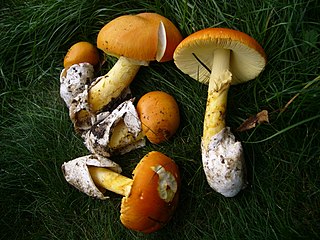
Amanita caesarea, commonly known as Caesar's mushroom, is a highly regarded edible mushroom in the genus Amanita, native to southern Europe and North Africa. While it was first described by Giovanni Antonio Scopoli in 1772, this mushroom was a known favorite of early rulers of the Roman Empire.
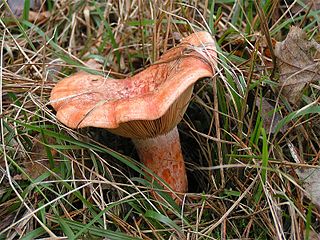
Lactarius deliciosus, commonly known as the delicious milk cap, saffron milk cap and red pine mushroom, is one of the best known members of the large milk-cap genus Lactarius in the order Russulales. It is native to Europe, but has been accidentally introduced to other countries along with pine trees, with which the fungus is symbiotic.

Russula vesca, known by the common names of bare-toothed Russula or the flirt, is a basidiomycete mushroom of the genus Russula.

Coprinus comatus, commonly known as the shaggy ink cap, lawyer's wig, or shaggy mane, is a common fungus often seen growing on lawns, along gravel roads and waste areas. The young fruit bodies first appear as white cylinders emerging from the ground, then the bell-shaped caps open out. The caps are white, and covered with scales—this is the origin of the common names of the fungus. The gills beneath the cap are white, then pink, then turn black and deliquesce ('melt') into a black liquid filled with spores. This mushroom is unusual because it will turn black and dissolve itself in a matter of hours after being picked or depositing spores.

Suillus granulatus is a pored mushroom of the genus Suillus in the family Suillaceae. It is similar to the related S. luteus, but can be distinguished by its ringless stalk. Like S. luteus, it is an edible mushroom that often grows in a symbiosis (mycorrhiza) with pine. It has been commonly known as the weeping bolete, or the granulated bolete. Previously thought to exist in North America, that species has now been confirmed to be the rediscovered Suillus weaverae.

Tricholoma equestre or Tricholoma flavovirens, commonly known as the man on horseback or yellow knight is a widely eaten but arguably toxic fungus of the genus Tricholoma that forms ectomycorrhiza with pine trees.
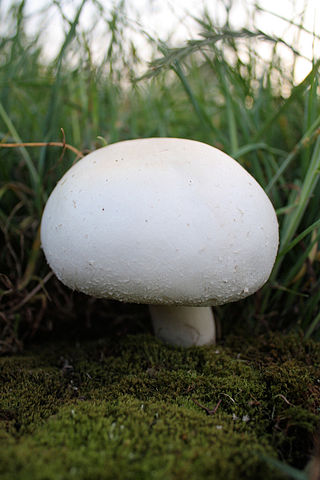
Agaricus arvensis, commonly known as the horse mushroom, is a mushroom-forming fungus of the genus Agaricus.

Agaricus campestris is a widely eaten gilled mushroom closely related to the cultivated A. bisporus. A. campestris is commonly known as the field mushroom or, in North America, meadow mushroom.
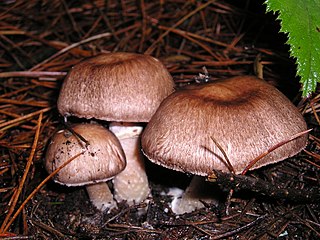
Agaricus subrutilescens, also known as the wine-colored agaricus, is a mushroom of the genus Agaricus. It was first described scientifically in 1925 as Psalliota subrutilescens, and later transferred to Agaricus in 1938.

Grifola frondosa is a polypore mushroom that grows at the base of trees, particularly old growth oaks or maples. It is typically found in late summer to early autumn. It is native to China, Europe, and North America.
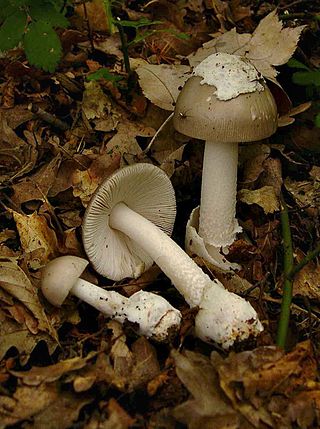
Amanita vaginata, commonly known as the grisette or the grisette amanita, is an edible mushroom in the fungus family Amanitaceae. The cap is gray or brownish, 5 to 10 centimetres in diameter, and has furrows around the edge that duplicate the gill pattern underneath. Unlike many other Amanita mushrooms, A. vaginata lacks a ring on the stem.
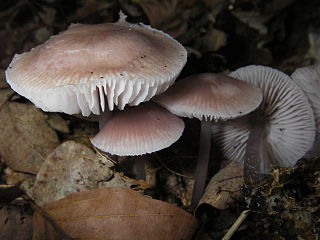
Mycena pura, commonly known as the lilac mycena, lilac bonnet, is a species of mushroom in the family Mycenaceae. First called Agaricus prunus in 1794 by Christian Hendrik Persoon, it was assigned its current name in 1871 by German Paul Kummer. Mycena pura is known to bioaccumulate the element boron.

Lyophyllum decastes, commonly known as the fried chicken mushroom, or chicken of the gravel, is an edible species of fungus in the family Lyophyllaceae that grows in clusters on disturbed ground, often near man-made roads in gravel, with a faintly radish-like taste.

Crepidotus mollis, commonly known as the peeling oysterling, soft slipper, jelly crep, or flabby crepidotus, is a species of mushroom. It's edibility is unknown, but it is probably inedible and possibly poisonous.

Clavaria zollingeri, commonly known as the violet coral or the magenta coral, is a widely distributed species of fungus. It produces striking tubular, purple to pinkish-violet fruit bodies that grow up to 10 cm (3.9 in) tall and 7 cm (2.8 in) wide. The extreme tips of the fragile, slender branches are usually rounded and brownish. A typical member of the clavarioid or club fungi, Clavaria zollingeri is saprobic, and so derives nutrients by breaking down organic matter. The fruit bodies are typically found growing on the ground in woodland litter, or in grasslands. Variations in branching and color can often be used to distinguish C. zollingeri from similarly colored coral fungi such as Alloclavaria purpurea and Clavulina amethystina, although microscopy is required to reliably identify the latter species.

Lactifluus corrugis, commonly known as the corrugated-cap milky, is an edible species of fungus in the family Russulaceae. It was first described by American mycologist Charles Horton Peck in 1880.

Amanita volvata, also known as volvate amanita is an inedible white-coloured species of fungi from the family Amanitaceae found in the southeastern United States. Can be confused with Amanita ponderosa, but that species is from the Iberian peninsula. The species is amyloid and have saccate volva, and elliptic spores.

Amanita excelsa, also known as the European false blushing amanita, is a species of agaric fungus in the family Amanitaceae. It is found in Asia, Europe, and North America, where it grows in deciduous forests.
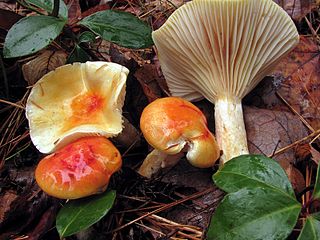
Hygrophorus speciosus, commonly known as the larch waxy cap, is a species of fungus in the genus Hygrophorus. While edible, the flavor of most Hygrophorus species is considered bland.

Pholiota squarrosoides is a species of mushroom in the family Strophariaceae. It is similar to the species Pholiota squarrosa. There are differing accounts on whether the mushroom is edible.





















